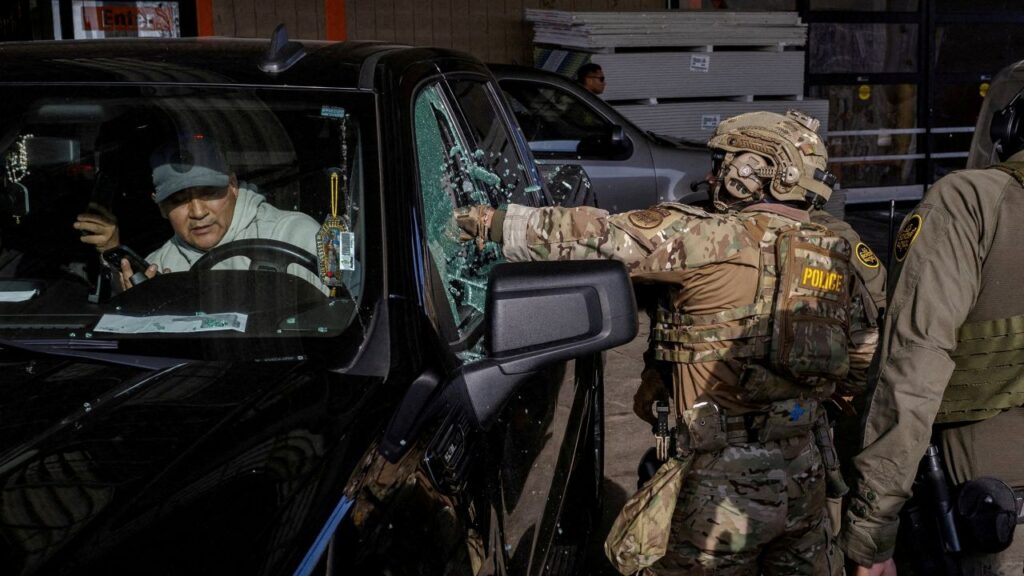Israeli drone attack on a major air base near the central city of Isfahan activated Iranian air defenses. (AP/Vahid Salemi)

- Tensions heighten between Israel and Iran, demonstrated by an Israeli drone attack on an Iranian air base.
- Iranian air defense systems activate in response to reports of drones in the air over several provinces.
- Regional tensions stem from incidents in Iran, Syria, and Iraq, raising concerns about potential Middle East escalations.
Share
|
Getting your Trinity Audio player ready...
|
DUBAI, United Arab Emirates — An apparent Israeli drone attack on a major air base near the central city of Isfahan activated Iranian air defenses early Friday. The strike came just days after Tehran’s unprecedented drone-and-missile assault on Israel.
No Iranian official directly acknowledged the possibility that Israel had attacked, and the Israeli military did not respond to a request for comment. However, regional tensions have been high since the Saturday assault on Israel amid its war on Hamas in the Gaza Strip and its own strikes targeting Iran in Syria.
Speaking at the G7 meeting in Capri, Italian Foreign Minister Antonio Tajani said the U.S. received “last-minute” information from Israel about the attack on Isfahan. U.S. Secretary of State Antony Blinken did not dispute that, but said: “We were not involved in any offensive operations.”
The apparent attack came on Iranian Supreme Leader Ayatollah Ali Khamenei’s 85th birthday. Israeli politicians also made comments hinting that the country had launched an attack.
Iran on the Defensive
Air defense batteries fired in several provinces over reports of drones being in the air, state television reported. Iranian army commander Gen. Abdolrahim Mousavi said crews targeted several flying objects.
“The explosion this morning in the sky of Isfahan was related to the shooting of air defense systems at a suspicious object that did not cause any damage,” Mousavi said. Others suggested the drones may be so-called quadcopters — four-rotor, small drones that are commercially available.
Related Story: US Vetoes Full United Nations Membership for Palestine
Authorities said air defenses fired at a major air base in Isfahan, which long has been home to Iran’s fleet of American-made F-14 Tomcats — purchased before the 1979 Islamic Revolution.
The Tasnim news agency published a video from one of its reporters, who said he was in the southeastern Zerdenjan area of Isfahan, near its “nuclear energy mountain.” The footage showed two different anti-aircraft gun positions, and details of the video corresponded with known features of the site of Iran’s Uranium Conversion Facility at Isfahan.
“At 4:45, we heard gunshots. There was nothing going on,” he said. “It was the air defense, these guys that you’re watching, and over there too.”
Why Attack Isfahan?
The facility at Isfahan operates three small Chinese-supplied research reactors, as well as handling fuel production and other activities for Iran’s civilian nuclear program.
Isfahan also is home to sites associated with Iran’s nuclear program, including its underground Natanz enrichment site, which has been repeatedly targeted by suspected Israeli sabotage attacks.
State television described all atomic sites in the area as “fully safe.” The United Nations’ nuclear watchdog, the International Atomic Energy Agency, also said “there is no damage to Iran’s nuclear sites” after the incident.
The IAEA “continues to call for extreme restraint from everybody and reiterates that nuclear facilities should never be a target in military conflicts,” the agency said.
Related Story: US and UK Issue New Sanctions on Iran in Response to Tehran’s Weekend ...
Iran’s Access to Nuclear Arms
Iran’s nuclear program has rapidly advanced to producing enriched uranium at nearly weapons-grade levels since the collapse of its atomic deal with world powers after then-President Donald Trump withdrew America from the accord in 2018.
While Iran insists its program is for peaceful purposes, Western nations and the IAEA say Tehran operated a secret military weapons program until 2003. The IAEA has warned that Iran now holds enough enriched uranium to build several nuclear weapons if it chose to do so — though the U.S. intelligence community maintains Tehran is not actively seeking the bomb.
Dubai-based carriers Emirates and FlyDubai began diverting around western Iran about 4:30 a.m. local time. They offered no explanation, though local warnings to aviators suggested the airspace may have been closed.
Iran then grounded commercial flights in Tehran and across areas of its western and central regions. Iran later restored normal flight service, authorities said.
Related Story: Netanyahu Dismisses Calls for Restraint, Says Israel Will Decide Iran Attack ...
Heightened Tensions in the Region
Around the time of the incident in Iran, Syria’s state-run SANA news agency quoted a military statement saying Israel carried out a missile strike targeting an air defense unit in its south and causing material damage. The Britain-based Syrian Observatory for Human Rights, an opposition war monitor, said the strike hit a military radar for government forces. It was not clear if there were casualties, the Observatory said.
That area of Syria is directly west of Isfahan, some 1,500 kilometers (930 miles) away, and east of Israel.
Meanwhile in Iraq, where a number of Iranian-backed militias are based, residents of Baghdad reported hearing sounds of explosions, but the source of the noise was not immediately clear.
The incident Friday in Iran also sparked concerns about the conflict again escalating across the seas of the Middle East, which have been seeing attacks by the Iranian-backed Houthi rebels of Yemen on shipping over the war in Gaza.
The British military’s United Kingdom Maritime Trade Operations center warned ships in the region that they could see increased drone activity in the skies.
“There are currently no indications commercial vessels are the intended target,” it wrote.
More Aggression in the Area
The Houthis have launched at least 53 attacks on shipping, seized one vessel and sank another since November, according to the U.S. Maritime Administration.
Houthi attacks have dropped in recent weeks as the rebels have been targeted by a U.S.-led airstrike campaign in Yemen and as shipping through the Red Sea and Gulf of Aden has declined over the threat.
The apparent attack also briefly spooked energy markets, sending benchmark Brent crude above $90 before it fell again in trading Friday.
However, Iranian state-run media sought to downplay the incident after the fact, airing footage of an otherwise-peaceful Isfahan morning. That could be intentional, particularly after Iranian officials for days have been threatening to retaliate for any Israeli retaliatory attack on the nation.
“As long as Iran continues to deny the attack and deflect attention from it and no further hits are seen, there is space for both sides to climb down the escalation ladder for now,” said Sanam Vakil, the director of the Middle East and North Africa program at Chatham House.



















